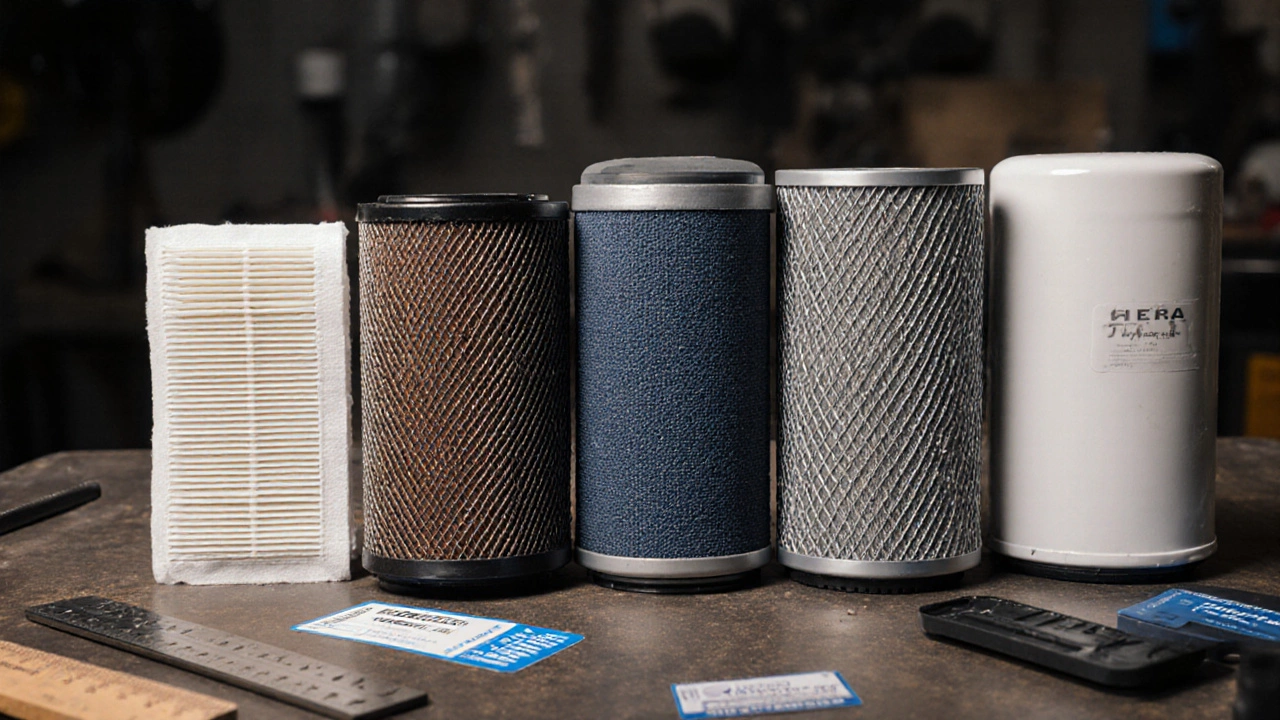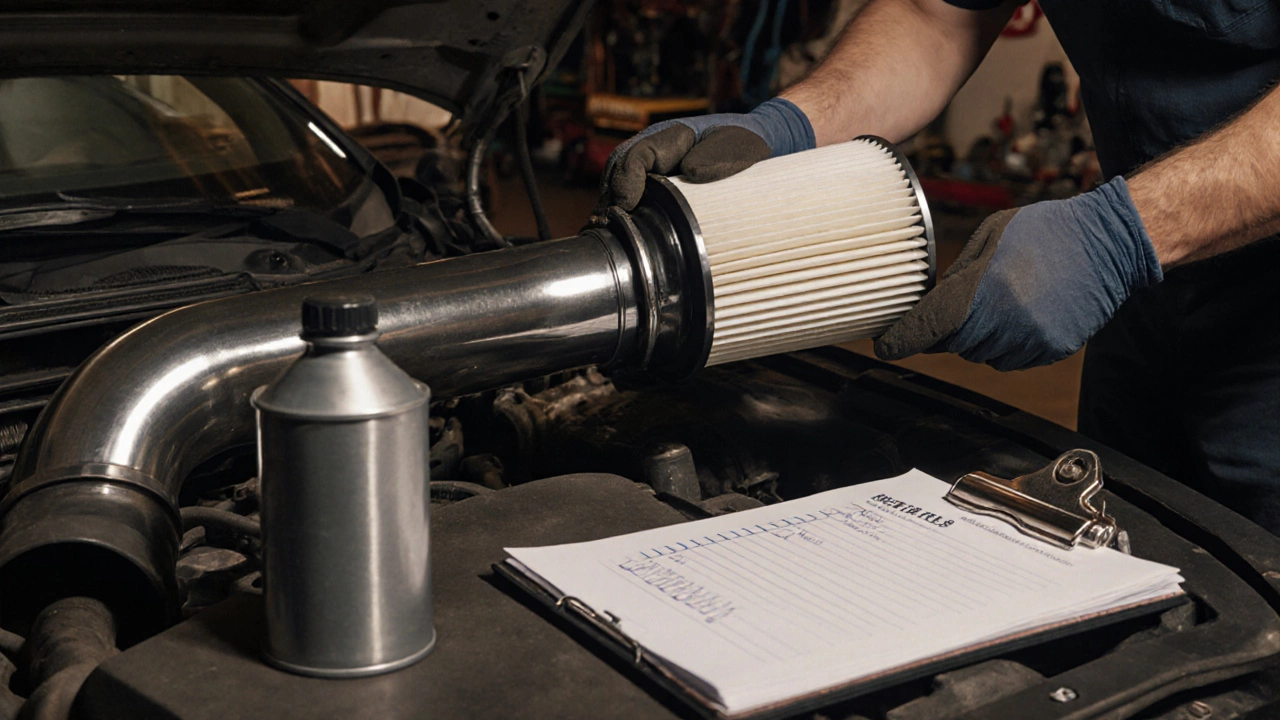 Oct, 8 2025
Oct, 8 2025
Air Filter Efficiency Comparison Tool
Select Your Driving Conditions
Select Filter Type
Recommended Filter for Your Conditions
Efficiency Comparison
Key Attributes
Quick Takeaways
- HEPA‑grade filters capture 99.97% of particles down to 0.3µm, making them the top choice for dust‑heavy environments.
- Cotton gauze filters offer high dust capacity but need regular cleaning to keep airflow smooth.
- Synthetic media filters balance efficiency and low pressure drop, suitable for most daily drivers.
- Paper OEM filters are inexpensive but only capture larger dust, so they rank lowest for fine‑particle removal.
- Proper installation and a simple maintenance routine extend filter life and maintain engine performance.
When you ask, “Which air filter removes the most dust?” the answer hinges on how the filter’s media interacts with airborne particles. Different materials-paper, oiled cotton, synthetic fibers, electrostatic elements, and HEPA‑grade media-each have a unique blend of filtration efficiency, airflow resistance, and durability. Below we break down the science, compare the major types, and give you a clear path to the best air filter for dust for your vehicle.
How Air Filters Work
Air filter is a component that traps dust, pollen, and microscopic debris before the air reaches the engine’s combustion chamber. By doing so, it protects piston rings, cylinder walls, and sensitive sensors from abrasion and wear.
Filtration happens through three primary mechanisms:
- Mechanical interception - particles larger than the media’s pores get physically caught.
- Inertial impaction - heavy particles can’t follow rapid airflow changes and slam into fibers.
- Electrostatic attraction - charged fibers pull in oppositely charged particles.
The balance between these mechanisms determines two key performance numbers: filtration efficiency (how much dust is actually captured) and pressure drop (how much the filter slows airflow). High efficiency usually means a higher pressure drop, which can reduce engine power if the filter is too restrictive.
Major Types of Automotive Air Filters
Below are the filter families you’ll encounter at auto parts stores and online marketplaces.
Paper (OEM) Filters
Paper filter is a disposable unit made of pleated cellulose paper treated with a light oil coating. It captures larger dust particles (10µm and above) with an efficiency of roughly 70‑80% for fine dust. Because the media is thin, the pressure drop stays low, preserving engine power.
Cotton Gauze (Oiled) Filters
Cotton gauze filter is a reusable filter built from layers of tightly woven cotton fabric that’s pre‑oiled. The oil acts as a sticky surface, raising capture rates to about 85‑90% for particles down to 5µm. The downside is a higher pressure drop that can be mitigated by regular cleaning.
Synthetic Media Filters
Synthetic media filter employs engineered polyester or polypropylene fibers arranged in a multi‑layer matrix. These filters typically achieve 90‑95% efficiency for particles as small as 1µm while keeping pressure drop moderate, making them a popular middle‑ground option.
Electrostatic Filters
Electrostatic filter uses positively charged fibers to attract negatively charged dust particles. Capture rates can exceed 95% for sub‑micron particles, but performance drops if the filter gets saturated with oily or greasy contaminants.
HEPA‑Grade Filters
HEPA filter (High‑Efficiency Particulate Air) is a dense web of fine glass or synthetic fibers rated to remove 99.97% of particles 0.3µm and larger. In automotive applications, HEPA‑style filters are sold as “performance” or “off‑road” upgrades. They deliver the highest dust‑removal numbers but introduce the greatest pressure drop, which can be managed by tuning the intake or adding a cold‑air box.

Side‑by‑Side Comparison
| Filter Type | Typical Efficiency (0.3µm) |
Pressure Drop (kPa) | Reusable? | Cost (USD) | Best Use Case |
|---|---|---|---|---|---|
| Paper | 70‑80% | Low (0.5‑0.8) | No | 15‑25 | Standard daily driving |
| Cotton Gauze | 85‑90% | Medium (1.0‑1.5) | Yes, with cleaning | 30‑45 | Dusty roads, off‑road |
| Synthetic Media | 90‑95% | Medium‑Low (0.8‑1.2) | Yes or No | 25‑40 | Balanced performance |
| Electrostatic | 95‑98% | Low‑Medium (0.6‑1.0) | No (usually disposable) | 30‑50 | Environments with fine ash or pollen |
| HEPA | 99.97% | High (1.5‑2.5) | Yes, with periodic cleaning | 50‑80 | Extreme dust, sand, or performance builds |
Which Filter Removes the Most Dust?
If sheer capture rate is your only metric, the HEPA filter reigns supreme. Its dense fiber matrix traps virtually every particle larger than 0.3µm, including the fine silica dust that can infiltrate a turbocharger or throttle body.
However, real‑world decisions involve trade‑offs. A HEPA filter’s higher pressure drop can shave a few horsepower off a naturally aspirated engine, and it may require a larger intake housing. For most street‑driven cars, a high‑efficiency synthetic media filter offers a sweet spot-over 90% dust removal with a modest pressure penalty.
In environments with constant sand or construction‑site dust, many enthusiasts pair a HEPA filter with a cold‑air intake kit to offset the airflow loss. If you’re on a budget or only face occasional dust, a properly oiled cotton gauze filter can hold more dirt before needing cleaning, which translates into fewer replacement purchases.
Installation & Maintenance Tips
Regardless of the filter you choose, the following steps keep performance consistent:
- Inspect the intake housing for cracks or debris before installing a new filter.
- Apply a thin, even coat of filter‑specific oil (for cotton or synthetic filters) only if the product recommends it.
- Seat the filter firmly; any gaps let unfiltered air bypass the media.
- After 12,000‑15,000km (or when you notice a drop in idle quality), remove the filter and evaluate dust buildup.
- For reusable filters, tap off loose dust, then wash with a gentle soap solution. Rinse thoroughly, let dry, and re‑oil if required.
Never reuse a paper filter-its pleats collapse after a single cleaning cycle, causing severe airflow restriction.

Maintenance Checklist
- Visual inspection every 6months.
- Pressure‑drop test (optional) if you have a gauge; a rise of >0.5kPa suggests cleaning or replacement.
- Re‑oil cotton or synthetic filters after each cleaning.
- Record the installation date and mileage for warranty tracking.
- Replace with the same filter type unless you’re ready for a performance‑focused redesign.
Frequently Asked Questions
Can a HEPA filter cause my engine to run rich?
A higher pressure drop can slightly enrich the air‑fuel mixture because the engine’s ECU compensates for reduced airflow. Most modern ECUs adjust on the fly, but you may notice a minor increase in fuel consumption unless you retune the fuel map.
Are oiled filters safe for turbocharged engines?
Yes, as long as you use the correct oil type and apply it sparingly. Too much oil can be drawn into the turbo’s bearings, so follow the manufacturer’s instructions precisely.
How often should I replace a paper filter?
Most OEM paper filters last between 12,000 and 20,000km, but harsh dusty conditions may demand a swap at the first sign of reduced idle smoothness.
Do synthetic filters need oil?
Not all synthetic filters require oil. Some are designed to be oil‑free, offering consistent performance without the extra maintenance step.
Is there a risk of fire with oily filters?
If the oil coating is applied excessively, it can melt under extreme engine heat and create a fire hazard. Always stick to the amount recommended by the filter maker.
Next Steps
Identify the dust level you regularly face, then match it to the filter type that balances capture rate with acceptable airflow loss. If you live near a construction site or sand‑filled road, a HEPA or high‑efficiency synthetic filter paired with a mild intake upgrade is worth the extra cost. For moderate dust, a cotton gauze filter gives you reusable convenience without a big power hit.
Finally, keep a record of the install date, perform the quick checklist every six months, and you’ll keep your engine breathing clean air for years to come.